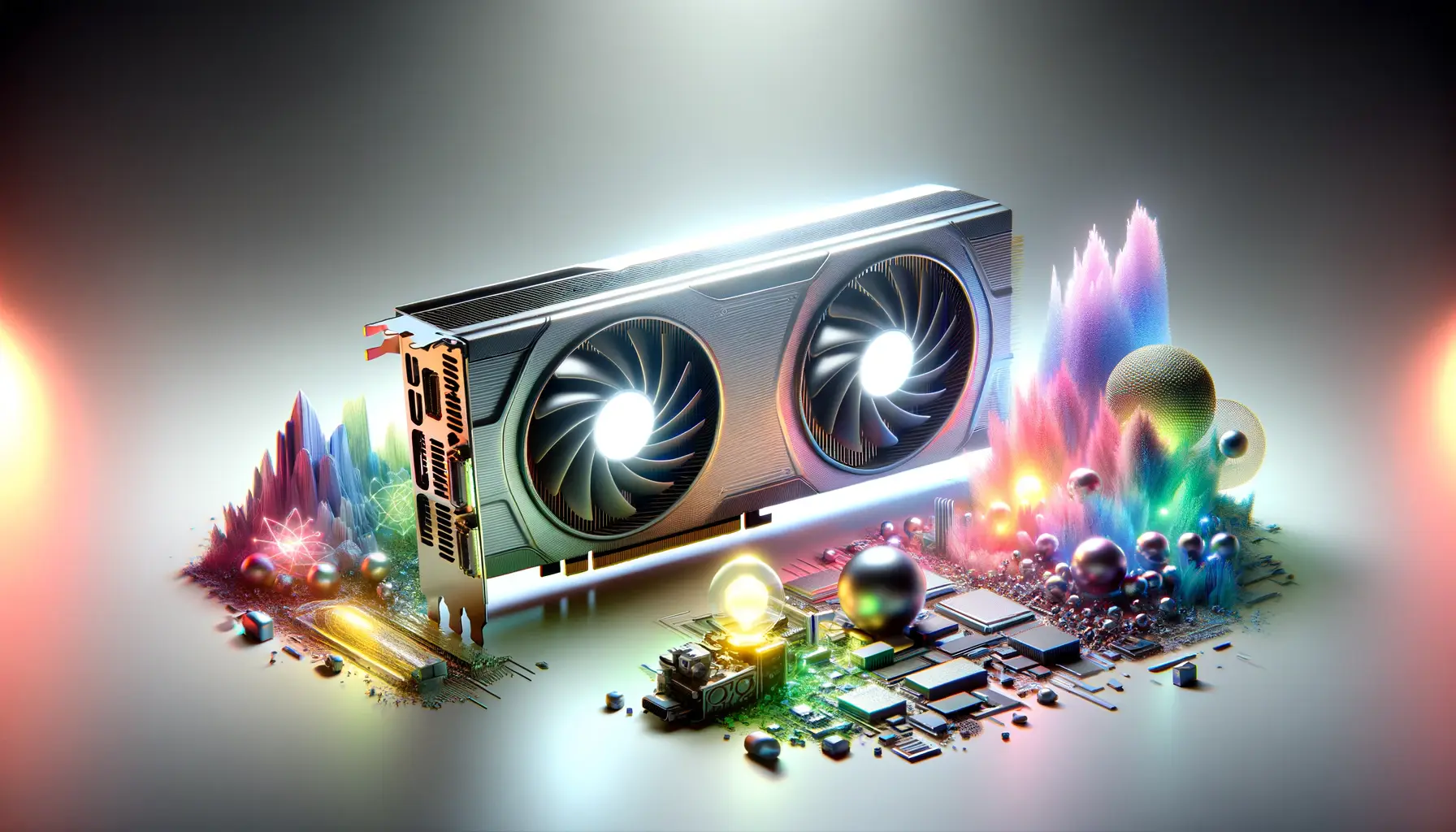The evolution of gaming graphics has been nothing short of revolutionary, with technologies like NVIDIA’s Deep Learning Super Sampling (DLSS) and AMD’s FidelityFX Super Resolution (FSR) leading the charge.
These technologies have become pivotal in enhancing gaming experiences, offering improved performance and image quality without the need for high-end hardware.
This article delves into a comparative analysis of DLSS 3 and AMD FSR, focusing on their impact on gaming visuals and performance.
Through this exploration, we aim to provide valuable insights into how these technologies stack against each other and their significance in the gaming industry.
At the heart of this comparison is the main keyword “comparative,” guiding our analysis towards understanding the nuances that differentiate DLSS 3 from AMD FSR.
As we navigate through this topic, we will explore various aspects of these technologies, including their working mechanisms, performance benchmarks, compatibility with gaming titles, and the overall gaming experience they offer.
This comprehensive approach ensures that the content is not only informative but also relevant and closely aligned with the interests of gaming enthusiasts and tech aficionados alike.
- Introduction to DLSS and AMD FSR
- Performance and Image Quality Comparison
- Technological Innovations Behind DLSS and FSR
- User Experience and Accessibility
- Future Developments and Industry Impact
- Comparative Analysis in Gaming Communities
- Challenges and Limitations
- Embracing the Future of Gaming with DLSS and FSR
- DLSS 3 and AMD FSR: Frequently Asked Questions
Introduction to DLSS and AMD FSR
Understanding DLSS Technology
NVIDIA’s DLSS, or Deep Learning Super Sampling, represents a groundbreaking approach to rendering high-quality graphics without the traditional computational cost.
Utilizing advanced AI and machine learning algorithms, DLSS analyzes thousands of game frames and intelligently enhances each frame’s quality.
This process not only improves frame rates but also delivers sharper images, making games look stunning while running smoother on less powerful hardware.
The introduction of DLSS 3 has further refined this technology, offering even greater performance improvements and visual fidelity enhancements.
The Evolution of AMD FSR
On the other side of the spectrum, AMD’s FidelityFX Super Resolution (FSR) offers a different approach to upscaling and performance enhancement.
FSR focuses on increasing frame rates by rendering games at a lower resolution and then upscaling them to the target resolution using a spatial upscaling algorithm.
This method significantly boosts performance, especially on lower-end hardware, without heavily compromising on image quality.
With the release of FSR 3, AMD has introduced new features and optimizations aimed at closing the gap with NVIDIA’s DLSS, making it a formidable competitor in the realm of game graphics enhancement.
Both DLSS and AMD FSR are designed to improve gaming performance and visual quality, but they employ distinct technologies and algorithms to achieve these goals.
The introduction of these technologies marks a significant milestone in the gaming industry, offering gamers the ability to experience high-quality visuals without needing top-tier hardware.
As we proceed, we’ll dive deeper into the comparative analysis of DLSS 3 and AMD FSR, shedding light on their performance, compatibility, and overall impact on the gaming experience.
Performance and Image Quality Comparison
The core of any comparative analysis between DLSS 3 and AMD FSR revolves around two critical aspects: performance and image quality.
These factors are paramount in determining the overall gaming experience, influencing not just how a game looks but also how smoothly it runs.
In this section, we delve into the intricacies of how DLSS 3 and AMD FSR stack up against each other in these domains, providing a clearer picture of their capabilities and limitations.
When evaluating performance, it’s essential to consider the frame rate improvements each technology offers across various hardware configurations.
Similarly, image quality assessment involves looking at the clarity, detail, and overall visual fidelity that DLSS 3 and AMD FSR can achieve.
Here’s a breakdown of these aspects:
- Frame Rate Improvements: Both DLSS 3 and AMD FSR aim to boost frame rates, but they do so through different mechanisms. DLSS 3, with its AI-driven approach, tends to provide substantial performance boosts, especially on RTX series GPUs. AMD FSR, while also effective in enhancing frame rates, relies on a more straightforward upscaling technique that can be more universally applied across a wider range of hardware, including GPUs from other manufacturers.
- Visual Fidelity: DLSS 3’s deep learning algorithms allow it to reconstruct high-quality images that can sometimes surpass native resolution quality, especially in motion. AMD FSR’s latest iteration has made significant strides in image quality, reducing artifacts and improving clarity, though it may still lag slightly behind DLSS 3 in terms of raw image fidelity.
Game Compatibility and Support
Another crucial factor in the performance and image quality comparison is game compatibility and support.
DLSS 3 requires specific support from game developers to be integrated into games, which can limit its availability to a selection of titles.
However, the games that do support DLSS 3 benefit immensely from its features.
AMD FSR, being an open standard, has been adopted more widely, allowing a broader range of games to take advantage of performance improvements, albeit with varying degrees of optimization.
Real-World Gaming Scenarios
To truly understand the impact of DLSS 3 and AMD FSR, examining their performance in real-world gaming scenarios is essential.
Games like “Cyberpunk 2077” and “Control” have shown remarkable improvements with DLSS 3, offering smoother gameplay and enhanced visuals.
AMD FSR has shown its strength in games like “Deathloop” and “Godfall,” where it significantly boosts frame rates, making gameplay more fluid on a variety of hardware setups.
While both technologies offer their unique advantages, the choice between DLSS 3 and AMD FSR often comes down to personal preference, specific game support, and hardware compatibility.
In summary, the performance and image quality comparison between DLSS 3 and AMD FSR reveals a competitive landscape where both technologies bring valuable enhancements to the gaming experience.
As we move forward, continuous improvements and updates to both DLSS and FSR are expected, further closing the gap between them.
Technological Innovations Behind DLSS and FSR
The technological foundations of DLSS and FSR are what set them apart not only from each other but also from traditional rendering techniques.
These innovations are crucial for understanding how each technology enhances gaming performance and visual quality.
By delving into the mechanics behind DLSS and FSR, we can appreciate the significant strides made in gaming technology.
DLSS, or Deep Learning Super Sampling, is built upon NVIDIA’s proprietary AI algorithms and neural networks.
This technology leverages the power of deep learning to analyze and improve game frames in real-time.
The process involves:
- Training AI models on a supercomputer using ultra-high-quality game frames.
- Using these models to predict and generate high-quality images from lower-resolution inputs.
- Employing Tensor Cores on NVIDIA GPUs to efficiently process these AI calculations, enhancing both image quality and performance.
AMD’s FSR, or FidelityFX Super Resolution, on the other hand, takes a different approach.
It focuses on spatial upscaling techniques that do not rely on AI or machine learning.
The key components of FSR include:
- A sophisticated algorithm that upscales lower-resolution images to higher resolutions with minimal loss in quality.
- Optimizations that reduce latency and improve frame rates across a wide range of gaming titles and hardware.
- Compatibility with a broad spectrum of GPUs, including those from AMD, NVIDIA, and even Intel, making it a versatile option for gamers.
Impact on Gaming Hardware
The impact of these technologies extends beyond just software and affects gaming hardware as well.
DLSS’s reliance on Tensor Cores means that it is exclusive to NVIDIA’s RTX series GPUs, which are equipped with these specialized cores.
This exclusivity enhances the value proposition of NVIDIA’s hardware but also limits the technology’s availability to a subset of gamers.
FSR’s hardware-agnostic approach means it can be implemented across a much wider range of devices, from high-end gaming PCs to consoles and even mobile devices.
This inclusivity broadens the potential impact of FSR, allowing more gamers to benefit from improved performance and visuals without being tied to a specific brand of GPU.
The technological innovations behind DLSS and FSR highlight the diverse approaches taken by NVIDIA and AMD to solve the common challenge of enhancing gaming performance and visual quality.
In conclusion, the technological underpinnings of DLSS and FSR are a testament to the rapid advancements in gaming technology.
As these technologies continue to evolve, they promise to further revolutionize the gaming experience, pushing the boundaries of what’s possible in terms of performance and visual fidelity.
User Experience and Accessibility
The ultimate value of any technology lies in its ability to enhance the user experience.
For gamers, this means not just better performance or visuals, but also ease of use, accessibility, and the ability to customize settings to suit individual preferences.
DLSS and FSR, while technologically sophisticated, are designed with the end-user in mind, offering various features that cater to a broad spectrum of gaming enthusiasts.
DLSS’s integration into games allows users to select from multiple performance modes, including Quality, Balanced, Performance, and Ultra Performance.
These options give gamers the flexibility to prioritize either image quality or frame rate, depending on their hardware capabilities and personal preferences.
The ease of toggling DLSS settings within games ensures that users can effortlessly adjust their gaming experience without needing to navigate complex menus or configurations.
- Quality Mode: Maximizes visual fidelity, ideal for high-end systems.
- Balanced Mode: Offers a compromise between performance and quality.
- Performance Mode: Prioritizes frame rate for smoother gameplay on mid-range systems.
- Ultra Performance Mode: Designed for extremely high resolutions, such as 8K, focusing on maximizing frame rates.
AMD’s FSR also provides similar scalability, with modes like Performance, Balanced, Quality, and Ultra Quality.
This scalability ensures that FSR can be utilized across a wide range of hardware, from older GPUs to the latest models, without excluding any segment of the gaming community.
Additionally, FSR’s open-source nature means that it can be easily integrated into both new and existing games, further enhancing its accessibility.
Community and Developer Support
The support from the gaming community and developers plays a crucial role in the adoption and success of technologies like DLSS and FSR.
NVIDIA and AMD have both fostered strong relationships with game developers, leading to the integration of their technologies into a growing list of titles.
Community feedback has also been instrumental in refining these technologies, with updates and improvements often based on user experiences and suggestions.
Moreover, the open-source aspect of FSR encourages community involvement, allowing independent developers and hobbyists to experiment with and contribute to the technology.
This collaborative approach not only accelerates the improvement of FSR but also promotes a sense of ownership and engagement within the gaming community.
The user experience and accessibility of DLSS and FSR underscore the importance of designing technology that is not only powerful but also user-friendly and inclusive, ensuring that the widest possible audience can benefit from advancements in gaming graphics.
In essence, DLSS and FSR have significantly impacted the gaming landscape by offering technologies that enhance the gaming experience while being accessible and customizable.
As these technologies continue to evolve, their influence on user experience and accessibility is expected to grow, further democratizing high-quality gaming experiences for all.
Future Developments and Industry Impact
The dynamic nature of the gaming industry, driven by continuous technological advancements, suggests that the evolution of DLSS and FSR is far from over.
Both NVIDIA and AMD are committed to further developing their technologies, with future updates poised to address current limitations and introduce new features.
The trajectory of these developments not only promises to enhance gaming experiences but also to influence the broader gaming industry and hardware market.
Anticipated advancements in DLSS and FSR are expected to focus on improving efficiency, reducing latency, and expanding compatibility with a wider range of games and hardware.
NVIDIA’s ongoing research into AI and machine learning could lead to DLSS becoming even more adept at producing high-quality images from lower-resolution inputs, potentially making real-time ray tracing more accessible to gamers without high-end hardware.
Similarly, AMD’s work on FSR aims to refine its upscaling techniques to offer even better image quality and performance across its broad compatibility spectrum.
- Efficiency Improvements: Future versions of DLSS and FSR may require less computational power, making them more accessible to gamers with mid-range hardware.
- Latency Reduction: Enhancements aimed at reducing input lag will make fast-paced and competitive gaming smoother and more responsive.
- Broader Game Support: Increased adoption by game developers, driven by easier integration and community demand, will make DLSS and FSR features more widespread.
Impact on Hardware Development
The advancements in DLSS and FSR technologies are also influencing the development of gaming hardware.
GPU manufacturers may prioritize features like AI processing capabilities or support for advanced upscaling techniques in their future products.
This shift could lead to a new generation of graphics cards that are optimized not just for raw performance but also for efficiency and compatibility with game-enhancing technologies like DLSS and FSR.
Furthermore, the competition between NVIDIA and AMD in this space is fostering innovation, pushing both companies to continuously improve their offerings.
This healthy competition benefits the end-users—gamers—who can expect more advanced technologies that enhance their gaming experience without necessitating frequent, costly hardware upgrades.
The future developments in DLSS and FSR technologies are set to redefine gaming visuals and performance, marking a significant shift in how games are developed, played, and experienced. The ongoing evolution of these technologies reflects the gaming industry’s broader trends towards more immersive, accessible, and visually stunning gaming experiences.
In conclusion, the anticipated future developments of DLSS and FSR are poised to have a profound impact on the gaming industry.
By pushing the boundaries of what’s possible in game rendering and performance enhancement, these technologies are not only improving the gaming experience but also shaping the future of game development and hardware innovation.
Comparative Analysis in Gaming Communities
The reception and adoption of DLSS and FSR within gaming communities provide a unique lens through which to view these technologies.
Gamers’ preferences, experiences, and discussions around DLSS and FSR highlight the practical implications of these technologies in real-world gaming setups.
Engaging with gaming communities offers insights into how DLSS and FSR are perceived, the impact they have on gaming experiences, and the preferences that emerge among different segments of gamers.
Online forums, social media platforms, and gaming conventions serve as vibrant arenas for discussions about DLSS and FSR.
Through these discussions, several trends have emerged:
- Gamers with NVIDIA hardware tend to appreciate the visual quality improvements and performance boosts provided by DLSS, especially in titles that support ray tracing.
- AMD GPU users and those with hardware from other manufacturers often lean towards FSR for its broad compatibility and performance enhancements across a wide range of titles.
- There is a growing interest in comparing the two technologies directly, with many gamers conducting their own tests to determine which technology better suits their needs.
Community Feedback and Developer Response
Feedback from the gaming community is invaluable for both NVIDIA and AMD, as it shapes the future development of DLSS and FSR.
Developers closely monitor community feedback to identify areas for improvement, gauge satisfaction levels, and understand gamers’ desires.
This feedback loop has led to several updates and enhancements to both technologies, making them more efficient, compatible, and visually impressive.
Moreover, the active participation of the community in beta testing and providing detailed feedback has helped identify bugs and optimize performance across a broader range of games and hardware configurations.
This collaborative approach between developers and the gaming community ensures that DLSS and FSR continue to evolve in ways that directly address the needs and preferences of gamers.
The comparative analysis within gaming communities underscores the importance of user feedback in the development and refinement of game-enhancing technologies like DLSS and FSR.
In essence, the dialogue between gaming communities and technology developers is crucial for the continuous improvement of DLSS and FSR.
As these technologies evolve, they reflect the collective input of a diverse and passionate community, ensuring that future iterations will bring even greater benefits to gamers worldwide.
Challenges and Limitations
Despite the significant advancements and benefits brought by DLSS and FSR, these technologies are not without their challenges and limitations.
Understanding these aspects is crucial for both consumers and developers, as it highlights areas for potential improvement and sets realistic expectations for what these technologies can achieve.
Addressing these challenges is also essential for the continued evolution and adoption of DLSS and FSR in the gaming industry.
One of the primary challenges facing DLSS and FSR is the variability in performance and quality across different games and hardware configurations.
While both technologies aim to improve gaming experiences, the extent of their effectiveness can vary significantly depending on the game’s optimization, the hardware in use, and the settings selected by the user.
This variability can sometimes lead to inconsistent experiences, where the benefits of DLSS or FSR are not as pronounced in some scenarios as they are in others.
- Game Optimization: The success of DLSS and FSR heavily relies on how well a game is optimized for these technologies. Games that are not fully optimized may not see as significant performance gains or may exhibit visual artifacts.
- Hardware Compatibility: While FSR aims to be broadly compatible, DLSS requires specific NVIDIA hardware to function. This limitation can exclude a portion of the gaming community from experiencing the benefits of DLSS.
- User Expectations: Managing user expectations can be challenging, especially when comparing the performance and visual quality improvements offered by DLSS and FSR. Gamers may have unrealistic expectations about the capabilities of these technologies, leading to disappointment in some cases.
Overcoming Challenges
Overcoming the challenges associated with DLSS and FSR requires a multifaceted approach.
Continuous technological development, closer collaboration between hardware manufacturers and game developers, and clear communication with the gaming community are all essential strategies.
By addressing these challenges, NVIDIA and AMD can enhance the effectiveness of their technologies, ensuring that a wider range of games and users can benefit from improved performance and visual quality.
Furthermore, educating the gaming community about the realistic benefits and limitations of DLSS and FSR can help set appropriate expectations.
Providing detailed guides, tutorials, and transparent communication about how these technologies work and their potential impact on different games and hardware setups can empower gamers to make informed decisions about using DLSS and FSR.
While DLSS and FSR offer significant benefits, it’s important to recognize their limitations and the challenges that need to be addressed for these technologies to reach their full potential.
In conclusion, the challenges and limitations of DLSS and FSR highlight the ongoing need for development and optimization in the field of game-enhancing technologies.
By acknowledging and addressing these challenges, the gaming industry can continue to advance, offering gamers ever-improving experiences that push the boundaries of what’s possible in digital entertainment.
Embracing the Future of Gaming with DLSS and FSR
The journey through the comparative analysis of DLSS 3 and AMD FSR reveals a landscape rich with innovation, challenges, and immense potential.
These technologies stand at the forefront of a revolution in gaming, offering pathways to experiences that were once thought to be years away.
As we look towards the future, it’s clear that DLSS and FSR are not just temporary fixtures but pivotal elements that will shape the evolution of gaming graphics and performance.
The Path Forward
The comparative journey of DLSS and FSR underscores a critical narrative in the gaming industry: the relentless pursuit of excellence.
NVIDIA and AMD have laid down the gauntlet, challenging the status quo and pushing the boundaries of what’s possible in gaming.
The path forward is one of continuous improvement, where feedback from the gaming community and collaboration with developers will drive the next wave of innovations.
As these technologies mature, gamers can look forward to even more immersive and visually stunning gaming experiences, accessible across a broader spectrum of hardware.
Key Takeaways
- DLSS and FSR are transformative technologies that enhance gaming performance and visual quality, each leveraging unique approaches to achieve these goals.
- The future developments of DLSS and FSR promise to address current limitations, offering improved efficiency, reduced latency, and broader compatibility.
- The gaming community plays a crucial role in shaping the evolution of these technologies, with their feedback and experiences driving continuous refinement.
- Despite challenges and limitations, the potential of DLSS and FSR to redefine gaming experiences remains undiminished, signaling an exciting era ahead for gamers and developers alike.
Conclusion
In conclusion, the comparative analysis of DLSS 3 and AMD FSR offers a glimpse into the future of gaming—a future where technology breaks down barriers to immersive experiences and brings dreams to digital life.
As we stand on the brink of this new era, the commitment of NVIDIA and AMD to innovation, coupled with the passion of the gaming community, promises to usher in a period of unprecedented growth and creativity in gaming.
The journey of DLSS and FSR is far from over; it is just beginning.
And for gamers and developers alike, the road ahead is filled with limitless possibilities, ready to be explored and experienced.
DLSS 3 and AMD FSR: Frequently Asked Questions
As the gaming community continues to explore and discuss the comparative advantages of DLSS 3 and AMD FSR, several questions frequently arise. Here, we aim to address these queries, providing clear and concise answers to help gamers and enthusiasts better understand these groundbreaking technologies.
DLSS 3 utilizes AI and machine learning for image upscaling, while AMD FSR uses a spatial upscaling technique without AI.
No, DLSS 3 is exclusive to NVIDIA’s RTX series graphics cards due to its reliance on Tensor Cores.
Yes, AMD FSR is designed to be hardware-agnostic, making it compatible with a wide range of GPUs, including NVIDIA’s.
Both technologies aim to boost gaming performance by improving frame rates while also enhancing or maintaining image quality.
DLSS 3 generally offers superior image quality due to its AI-driven approach, especially in motion and at higher resolutions.
Yes, several games support both technologies, allowing users to choose based on their hardware and preferences.
Both can be enabled in the game’s graphics settings, often with options to adjust the level of performance or quality.
DLSS 3 can reduce input lag with NVIDIA Reflex technology. FSR focuses on performance improvement, which can indirectly affect input responsiveness.













